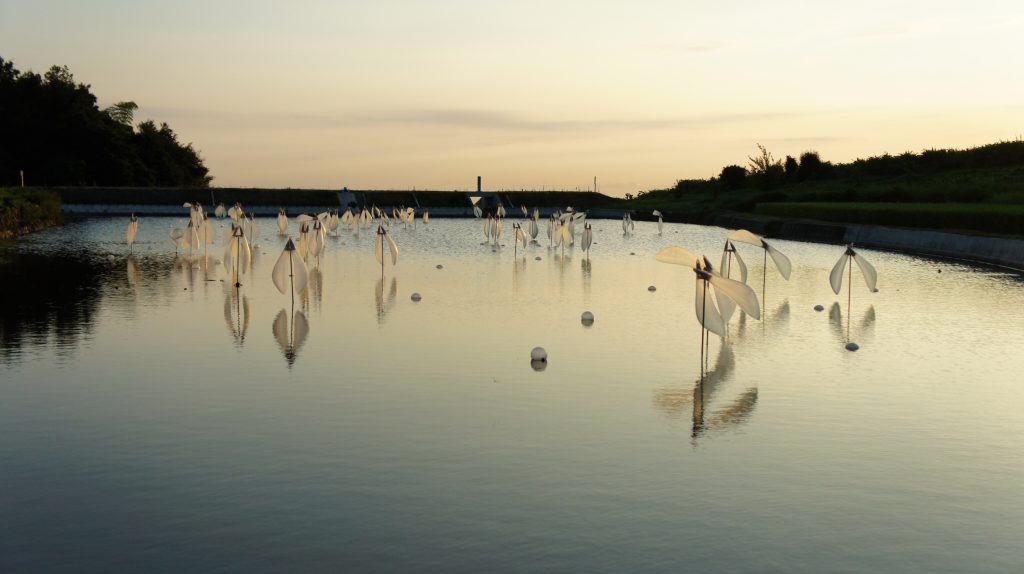Almost Lost Islands Dedicated to the Arts
Theatre, dance and other performances enhance the festival programme, while volunteers lead guided tours that cover local food and tea ceremonies.
Imagine boarding the Gozo ferry and being surrounded by contemporary art while approaching your destination. That is the impression you get when you take the 20 minutes’ crossing from Uno Port on Honshu/Japan to the “art island” of Naoshima. The ferry is generously decorated with framed pictures and collages, the colours of the seats are bright and the whole atmosphere uplifts your mind. This picturesque region of the Seto Inland Sea has become famous for the Setouchi Triennale, which started in 2010. The organisers tell us that this edition’s theme is the restoration of the sea and the revitalisation of the island communities that once thrived there.

Setouchi Girl’s Theatre, Shintaro Miyawaki
Naoshima, about a fifth of the size of Gozo, houses a number of contemporary art museums and site-specific installations. It was a mayor with foresight who, in 1988, developed the idea to turn the grounds of the Mitsubishi Central Smelting Works into the Naoshima Cultural Village. He wanted Naoshima to be an ‘honest island’, without the pollution and industrial debris it then housed. With the support of Japan’s unconventional architect, Tadao Ando (b. 1941), the plan has materialised over the past decades. So the Ando Museum is a good starting point for the visit. It is a 100-year-old wooden house filled with Ando’s signature concrete interior elements; thus, the exhibition space combines old and new and introduces the Pritzker Prize-winner’s work.
There are still more than 3,000 inhabitants in Naoshima and the best way to explore the island is by rental bike. On two wheels, you will pass well-kept dwellings and will quickly reach the first house of the Art House Project. Artists took over empty houses scattered about the residential area and turned the spaces into works of art, weaving the history and memories of the homes into their work. There is Haisha, the old dentist’s house, as well as Minamidera, a building designed by Ando and appropriated by the light artist James Turrell. The Art House Project started in 1998 and now comprises seven houses. With each Triennale more places are added, while the Honmura Lounge in the middle of the island serves as a bookshop and Triennale archive.

Naoshima is only one of 14 venues of the Setouchi Triennale. Other islands have been included to form The Sea of Hope – Oshima, for example, had previously served as a sanatorium for people with leprosy – and visitors can indulge in island-hopping across the different sites. The activities are divided into the Spring Encounters (April 26 to May 26), Summer Gatherings (July 19 to August 25) and Fall Expansions (September 28 to November 4). Theatre, dance and other performances enhance the festival programme, while volunteers lead guided tours that cover local food and tea ceremonies.
Artist Chiyoko Todaka (b. 1966) has participated in the Setouchi Triennale since its inception, and this year she redesigns her installation Teshima Sense. The island of Teshima was infamous for illegal and dangerous waste disposal, but inhabitants made the grounds arable again. Todaka has placed myriad transparent wings in an agricultural pond, and they float in pairs with the wind – the ephemeral existing in nature or society is her main concern. “Many spectators rest in contemplation and perceive the light and the air for a long time”, Chiyoko says of the work, “I am most interested in what has been discarded carelessly, forgotten and left behind”, she explains. “I feel captured and develop sympathy for these things. To find these values arrogantly neglected makes me angry. I see the value and beauty in them, which lead me to this work.”
The Triennale committee provides some background to the project, saying that during the 1960s Japan underwent rapid economic growth, but that the development of large-scale industries in the Setouchi region exacted a heavy toll in the form of environmental pollution. The landscape and cultural legacy of the Seto Inland Sea reflects both the positive and negative aspects of humankind’s interaction with the natural environment. With people moving back to inhabit some almost lost islands, defunct schools reopening, and with the introduction of art spots and the establishment of the Setouchi Triennale, there has been – to some extent – a reversed decline in the region.
If you don’t make it to the Setouchi Triennale this year, the area is still well worth a visit. Among the Benesse art sites on Naoshima, Teshima and Inujima are a collection of contemporary art spaces and architecture, the highlight of which is the Chichu Art Museum (art museum in the earth) in Naoshima, built mostly underground to avoid affecting the pristine scenery. Artworks by Claude Monet, James Turrell and Walter de Maria are on permanent display in the buildings, again designed by Tadao Ando. To make the experience complete, one should spend a night at the Benesse House Museum, a facility integrating a museum with a hotel and a sculpture garden at the sea. The Benesse art sites are connected with a shuttle bus that also stops at the Lee Ufan Museum, a tranquil location in resonance with nature, inviting to meditation


More information can be found on ww.setouchi-artfest.jp/en and www.benesse-artsite.jp.








